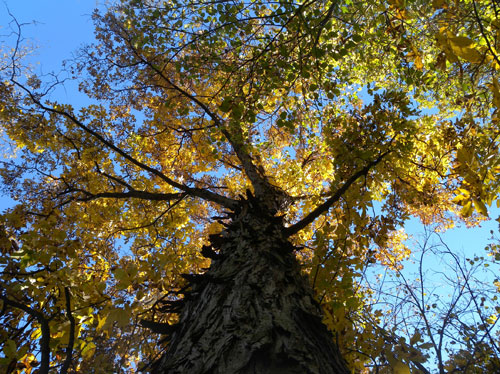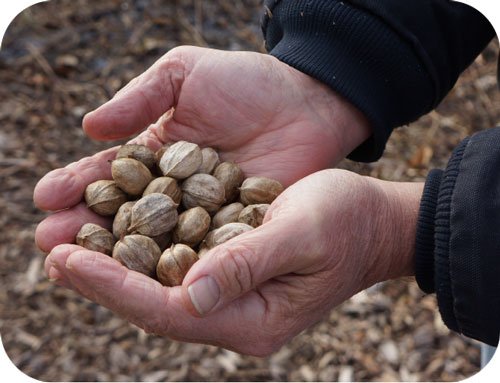November Wisdom from the Trees 2013
/Tree of the Month
Shagbark Hickory, Carya ovata
by Lesley Bruce Smith
ISA Certified Arborist
Shagbark Hickory Tree by Lesley Bruce SmithShagbark Hickory is one of the easier species to identify because its name says it all.
The shaggy exfoliating buttery grey bark is so distinctive any season of the year, it is a standout, even for the novice tree lover.
Carya ovata or Shagbark Hickory is a significant member of the Carya family and is a gift to us in many ways. Few of us have not enjoyed the savory scent of hickory smoked barbecue on a summer’s eve or relished the flavor of one of the Shagbark’s close relatives: the pecan (Carya illinoensis), in pie, or butter pecan ice cream (yummy). The Hickories produce some of the most delectable nuts in the world and every single hickory can be grown from its nut. Each crop of nuts is unique to the species of Hickory and in some measure to the season’s growing condition; very much like each season of grapes vary in the making of fine wine. The Cayuga Tribe used either the Kingnut or the Shagbark Hickory in remedies for arthritis and intestinal worms. A healthy high protein food, not unlike tofu, was also made from the nuts of the Shagbark Hickory by creating a nut cream using a hot water separation technique.
The Shagbark Hickory is one of the partners to Oaks in the northern Illinois climax forest ecosystems. Needless to say, they are a favorite of the squirrels, and trees that feed the squirrels help to expand the forest. The squirrels sense of smell permit them to discard diseased nuts and only bury=plant the healthy ones. Due to their ability to increase forest size and territory, with an increase in the squirrel population we will see an increase of other wildlife, including birds. There is even one species of butterfly which uses the Hickory as a host and is entirely dependent on it for life.
Our favorite and lifelong use of the Shagbark Hickory is in our backyard grill. Just a very small piece (1” x 2”) of bark, readily available on the forest floor around any Shagbark, creates a savory flavor to any meat on the grill and even turns a gas grill into a more BBQ flavor. Three cheers for the Hickories...yum yum yum!
The story continues.
Illinois soil and how it effects our trees.
Backyard Wisdom by Gilbert A Smith
ISA Certified Master Arborist
Sugar Maple seedlings germinated in northern Wisconsin soilIn September Wisdom from the Trees we talked about the soil history of Illinois. So who cares? Isn’t dirt dirt. Don’t all trees grow well in dirt?
When the European settlers arrived in Northern Illinois many of the Oaks alive today were just saplings, however, there were no native evergreens. Even today when your Austrian Pine drops thousands of seeds in your yard not one of them will germinate. The same is the case for White Pine, Scotts Pine, Birch, Beech, Sugar Maple, Arborvitae, Spruce, Fir and many others. Those little seeds have wisdom that they will not thrive in this environment. It is not the climate but the soil that tells them not to bother sprouting.
Arborvitae germinated on a rock on the northern shores of Lake Michigan The Prarie soil is too alkaline and too dense to support optimum tree root growth. If we plant these non-native trees they may live for many years but they will not thrive and they will constantly be under stress. Of course we love our Flowering Dogwood, Blue Spruce, and White Birch. But we have to realize that we are inviting them into a harsh soil environment that they would not choose to live in. They need special treatment.
Here is what the trees are telling us:
- Our roots can not expand in the heavy clay, poorly drained, alkaline soils of the prairie.
- Please provide space for our roots near the surface by mulching them out to the branch spread separating us from the lawn. (As is done at the Chicago Botanic Garden and the Morton Arboretum) (see our Mulching Abstract)
- During drought we need to be watered infrequently (no more than once a week) but heavily . According to the University of Illinois, sprinkling systems that go on every other day do more harm than good, both to trees and to lawns. (see Watering Abstract)
- Please plant us at least 8 inches higher than the surrounding soil surface and give us mulch or compost to grow above the clay. (see Planting Abstract)
- Don’t add soil, burying our roots.
- Avoid trenching, even shallow 4 inch deep trenching under our tree canopy. Lighting or sprinkler trenches can be catastrophic for us.
- When planting in the confused soils near buildings avoid using those of us who are sensitive to alkaline soils such as; Pin Oak, Red Maple, River Birch, Rhododendron.
- Have us annually inspected by our favorite Certified Arborist who loves us and will help us thrive in our difficult circumstances.
Understanding our unique Illinois soil history helps us nurture our beautiful Illinois trees.
Gilbert Smith ISA Master Arborist
The Greatest Fertilizer on Earth
Mother Nature's Moment
by Lesley Bruce Smith ISA Certified Arborist
Hybrid Maple in fall color by Lesley Bruce SmithJust available in an all new format is a fertilizer for trees that we just cannot keep to ourselves! A fertilizer, yes, but really so much more! It is packed with nitrogen, phosphorous and potassium. It is a root insulator that keeps roots protected from excessive heat in the summer and excessive cold in the winter. It is loaded with micro-nutrients, it has all kinds of micro-flora and fauna, it conserves moisture and acts as a mulch and amazingly it is completely renewable, organic and even beautiful. However, the most astonishing reality about this fertilizer is that it is absolutely FREE, yet every fall it is tossed away as though it was worthless, or even worse, a nuisance.
What is this amazing fertilizer?
The leaves that blanket our lawns each fall. Recently, in speaking with a friend we were reminded once again that many of us don’t know the wealth of resources that lay just at our feet every autumn. By separating lawns from grass using even small mulched or planting beds we have the marvelous reward of never having to rake our leaves. In 32 years of home ownership we have never raked leaves. We have a mulching mower, which most lawn mowers are now, and what doesn’t fall into our planting beds to be recycled gets munched by the mower and composted into the lawn, fertilizing and enriching that area of the landscape. So if you are panicking about not getting the leaves raked up or hate that particular chore, take a break! Do a favor to your trees and shrubs by leaving the leaves alone.
The Greatest Fertilizer by Lesley Bruce SmithLawn specialists will often say the lawn can’t take it, but our little acre of the world has a happy coexistence with trees and turf by just a little degree of separation. We have a lovely lawn which lives quite happily with five White Oaks on our property, a Riverbirch, a Catsura, a Hackberry, several fruit trees, three Crabtrees and a Native Hawthorne plus lots of Pine and Spruce trees as well as many shrubs and can I just say it again, we have never raked leaves or paid to apply supplemental fertilizer. If you need help giving up the habit of leaf raking give us a call, we would be thrilled to help you kick the habit and your trees will love you for it!
Lesley Bruce Smith, ISA Certified Arborist










